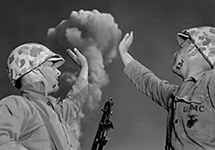January 19, 2016
Ferenc Dalnoki-Veress

Nuclear test at Yucca Flats, Nevada.
Source: National Atomic Veterans of America (naav.com)
When North Korea conducted a fourth nuclear test two weeks ago, the Korean Central News Agency stated that “The first H-bomb test was successfully conducted in the DPRK at 10:00 on Wednesday, Juche 105 (2016).” Since the Comprehensive Nuclear-Test-Ban Treaty (CTBT) is not in force, an on-site inspection is not possible. Although an “H-bomb” is unlikely, we are left speculating what to believe. This memo summarizes what evidence we can obtain from radionuclide measurements for different nuclear weapon types, and how we can detect the presence of specific nuclear weapon device components such as metals used. Most of what we learn requires quick extraction of aerosol samples containing gases and particulates. However, gases are unlikely to diffuse out from an underground nuclear test site soon after the test, and particulates would likely completely remain trapped underground.
